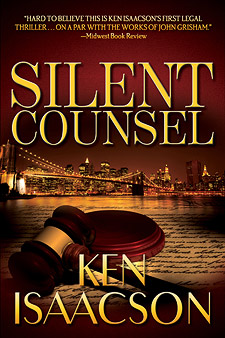A few months ago, I attended a reading at Third Place Books by new author and attorney Ken Isaacson. He was hawking his book, Silent Counsel. I forked over some cash for the book and, along with the author's autograph, received a free bookmark. Oh goodie! Of course, the bookmark advertised the book and included various accolades from reviewers.

Not wanting the marker to go to waste, I actually used it, but didn't really read any of it until recently. I noticed it also included a brief description of the book's plot. Much to my surprise, it looked just like an agent pitch. Its style was one I used myself at Willamette Writers a couple of years ago.
I tried to explain this pitching style, when asked to do so, at a Jessica Morrell workshop I attended earlier this year. Since my brain had long ago forgotten my own pitch, I mumbled and stumbled when explaining it. Now, there it was - that style - on Isaacson's bookmark. Here's how he presents his story:
Suppose the unimaginable: What if your child were killed in a hit-and-run? And the one person who knew the driver's identity - his lawyer - couldn't tell you his name because of a legal technicality? Suppose you were the lawyer, hired to negotiate a plea agreement with the prosecutor for that hit-and-run, but the client had directed you to not reveal his name until he's satisfied with the deal? And the court ordered your silence because the name was thus privileged information? Then the mother finds you, and she's determined to make you talk - at any cost... *
Oooh ... makes you want to know more, right?
Notice that the style isn't just a simple recitation of the plot. It doesn't even name the characters. It is presented as a series of vexing questions: "Suppose ...", "What if ...". Then, at the end is a statement, the zinger: She knows who you are and she's coming to get you!
This is the style I learned in "pitch practice" at Willamette Writers. You build curiosity by posing the book's initial premises as questions and suppositions. Then, you present the critical turning point that wreaks havoc for the main character, or causes everything to unravel.
This example is not your "five seconds in the elevator" pitch where you summarize your book in a sentence or two. Instead, this is what you'd use if you had five minutes face-to-face with an agent, and he/she says, "Tell me what it's about." The pitch doesn't necessarily have to explain the ending (as should a synopsis). If the agent likes it, he'll ask you, "Okay, what happens next?" Ahhh... music to your ears.
[ You can find more about Ken Isaacson at http://www.kenisaacson.com, and Jessica Morrell at http://thewritinglifetoo.blogspot.com. ]
* Reprinted with permission from Ken Isaacson.